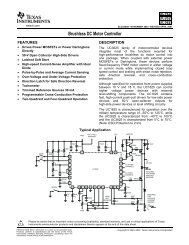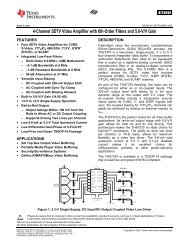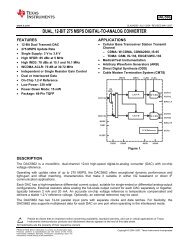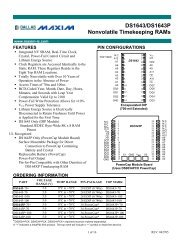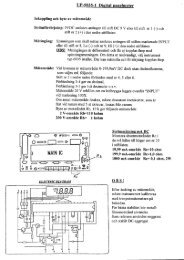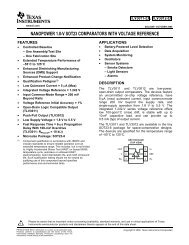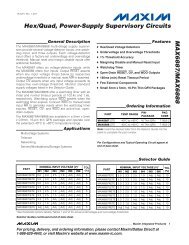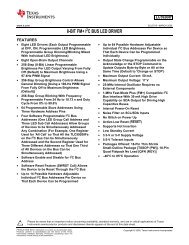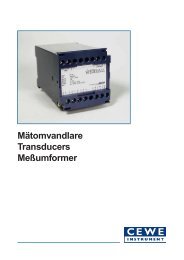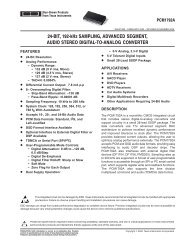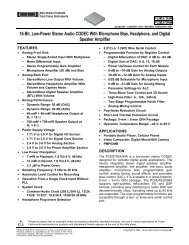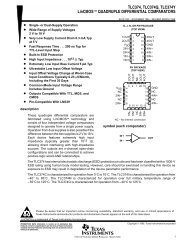Single-Chip Low Power RF Transceiver for Narrowband Systems ...
Single-Chip Low Power RF Transceiver for Narrowband Systems ...
Single-Chip Low Power RF Transceiver for Narrowband Systems ...
You also want an ePaper? Increase the reach of your titles
YUMPU automatically turns print PDFs into web optimized ePapers that Google loves.
12.11. Carrier Sense<br />
The carrier sense signal is based on the<br />
RSSI value and a programmable<br />
threshold.<br />
The carrier sense function can<br />
be<br />
used to simplify the implementation of a<br />
CSMA (Carrier Sense Multiple Access)<br />
medium<br />
access protocol.<br />
Carrier sense threshold level is<br />
programmed by CS_LEVEL[4:0] in the<br />
VGA4 register and VGA_SETTING[4:0] in<br />
the<br />
VGA3 register.<br />
VGA_SETTING[4:0] sets the maximum<br />
gain in the VGA. This value must be set so<br />
that the ADC works with optimum dynamic<br />
range <strong>for</strong> a certain channel filter<br />
bandwidth. The detected signal strength<br />
(after the ADC) will there<strong>for</strong>e<br />
depend on<br />
this<br />
setting.<br />
12.12. Automatic <strong>Power</strong>-up Sequencing<br />
CC1021<br />
has a built-in automatic power-up<br />
sequencing<br />
state machine. By setting the<br />
CC1021 into this mode, the receiver can be<br />
powered-up<br />
automatically by a wake-up<br />
signal and will then check <strong>for</strong> a carrier<br />
signal (carrier sense). If carrier sense is<br />
not detected, it returns to power-down<br />
mode. A flow chart <strong>for</strong> automatic power-up<br />
sequencing is shown in Figure 21.<br />
The<br />
automatic power-up sequencing mode<br />
is selected when PD_MODE[1:0] = 11 in<br />
the MAIN register. When the automatic<br />
power-up sequencing mode is selected,<br />
the<br />
functionality of the MAIN register is<br />
changed and used to control the<br />
sequencing.<br />
By<br />
setting SEQ_PD = 1 in the MAIN<br />
register, CC1021 is set in power down<br />
mode. If SEQ_PSEL = 1 in the<br />
SEQUENCING register the automatic<br />
power-up sequence is initiated by a<br />
negative transition on the PSEL pin.<br />
CC1021<br />
CS_LEVEL[4:0] sets the threshold <strong>for</strong> this<br />
specific VGA_SETTING[4:0] value. If the<br />
VGA_SETTING[4:0] is changed, the<br />
CS_LEVEL[4:0] must be changed<br />
accordingly to maintain the same absolute<br />
carrier sense threshold. See Figure 20 <strong>for</strong><br />
an explanation of the relationship between<br />
RSSI, AGC and carrier sense settings.<br />
The carrier sense signal can be read as<br />
the CARRIER_SENSE bit in the STATUS<br />
register.<br />
The carrier sense signal can also be made<br />
available at the LOCK pin by setting<br />
LOCK_SELECT[3:0] = 0100 in the LOCK<br />
register.<br />
If SEQ_PSEL = 0 in the SEQUENCING<br />
register, then the automatic power-up<br />
sequence is initiated by a negative<br />
transition on the DIO pin (as long as<br />
SEP_DI_DO = 1 in the INTE<strong>RF</strong>ACE<br />
register).<br />
Sequence timing is controlled through<br />
RX_WAIT[2:0] and CS_WAIT[3:0] in the<br />
SEQUENCING register.<br />
bration can be<br />
one every time, every 16 th VCO and PLL calibration can also be done<br />
automatically as a part of the sequence.<br />
This is controlled through SEQ_CAL[1:0]<br />
in the MAIN register. Cali<br />
d<br />
sequence,<br />
every 256 th sequence, or never. See the<br />
register description <strong>for</strong> details. A<br />
description of when to do, and how the<br />
VCO and PLL self-calibration is done, is<br />
given in section 15.2 on page 51.<br />
SWRS045B Page 41 of 89



